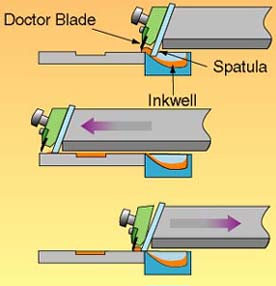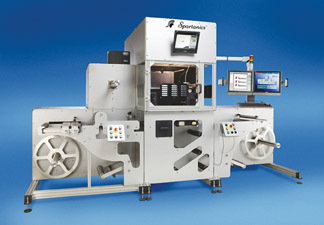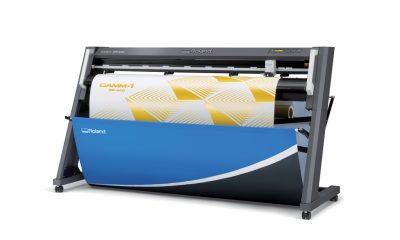Graphics Printing
Published
9 years agoon

For retailers, getting shoppers through the front door is just part of the battle. The next challenge is keeping them there. According to industry studies, within 10 seconds of walking into a retail establishment, shoppers decide whether to stay or go elsewhere.
For retailers, getting shoppers through the front door is just part of the battle. The next challenge is keeping them there. According to industry studies, within 10 seconds of walking into a retail establishment, shoppers decide whether to stay or go elsewhere.
In those precious few moments, the shopper immediately forms an impression about the store based on its appearance. Lighting, cleanliness, color, and layout all make an immediate and indelible impression on the shopper. One effective way to give a store interior a facelift—an increasingly popular alternative to more costly renovations involving fixtures and other architectural elements—is to install is a colorful wall graphic after giving the surface a fresh coat of paint.
For specialty printing companies, wall-graphics opportunities are not limited to retail stores. Museums, health clubs, schools, day care centers, and offices are also great candidates for programs. Printed wall graphics can give an old location a new look overnight. Remodeling an environment with graphics can also transform the attitudes of employees, students, and visitors.
While painting and applying pressure-sensitive graphics to flat surfaces sounds easy, problems can and do occur. Successful graphics programs depend on selecting the right materials for the application and following a few simple application rules.
Performing a site survey
One of the most important steps in any graphics program is conducting a site survey. Too often, this step is conducted haphazardly or not at all. Before you design a graphic, choose materials, or decide on the most effective manufacturing methods, take the time to visit the store location (or representative locations if a large chain of stores is involved). By conducting a thorough investigation, you will better understand the requirements of the job.
In addition to recording basic information such as the type of wall surface (concrete block, brick, industrial stucco, tile, etc.), the survey can also reveal any potential problems. The information that you or your salespeople collect is critical in designing, estimating, and planning the job. The survey is also an effective sales tool. Your professionalism in investigating the site and asking the right questions can help differentiate you from your competitors, establish a rapport with the prospect, and help you win the business.
As you survey the site, inspect the condition of the walls, looking carefully at the condition of the paint, any areas requiring special cleaning, and damage such as nail pops and gouges. Even if the existing paint seems to be in good condition, it will need to be redone if it has a matte rather than semi-gloss or gloss finish, as explained below. Walls stained from smoke or cooking grease must be thoroughly cleaned. Glaring imperfections in the coating of the taping compound over the drywall seams, corners, and nails will require the drywall contractor to apply a skim coat over these problem areas. You may think that applying graphics helps to hide these imperfections, but in fact they will be very noticeable if left unrepaired.
During the survey, be sure to record measurements and take photographs. Blueprints, if available, can be a great help in estimating material requirements. Take photographs of any problem areas as well any obstructions that you will have to deal with during the installation such as windows, cooler cases, display cases, and shelving. Also remember to ask about times you’ll be allowed to gain access to the site to do the work.
When surveying a commercial job site, such as a restaurant or convenience store, also look for walls that back up to cooling systems, water pipes, and overhead windows. These areas are prone to condensation, which can contribute to edge lifting and adhesion failure of the graphic you install.
Often, site inspections are done during the sales process, before an order has been taken. As you interview the owner or manager, probe to discover the project objectives, preferences for color, plans for expansion, and budget. Also try to determine who your competitors are. If the program involves redesigning the graphics, having a portfolio of store graphics your company has executed will help you communicate your ideas as well as stimulate a conversation to establish the likes and dislikes of the prospect.
Priming and painting
You might think that installing a wall graphic in a new retail store, with no store traffic or merchandise to move, should be easy. It isn’t! Recently constructed stores present unique problems, especially when contractors have rushed to get the job done.
The biggest concern is the condition of the drywall. If it hasn’t dried thoroughly and you attempt to paint over it, moisture will be trapped under the paint. Moisture is the primary reason that paint doesn’t stick to drywall, and can later cause it to peel, crack, and blister. And when the paint doesn’t stick, neither do the wall graphics.
Drywall also needs to be properly cleaned to ensure that the primer adheres properly and seals the surface. After the drywall is sanded, wipe it down with a clean, damp rag moistened with a mixture of 50% isopropyl alcohol and 50% water. The walls will usually be dry enough to paint after an hour.
Be sure you use a good product to prime the walls. Primer isn’t just cheap paint. It serves two very important functions: sealing the drywall and anchoring the finish to the wall. Some of the popular primers on the market include Prep & Prime Gripper water-based primer sealer #3210 from ICI Paints and oil-based primers by companies such as Kilz and Zinsser.
Some people prefer oil-based primers to latex. The advantage of an oil/alkyd primer is that it forms a barrier that prevents moisture from getting behind the applied vinyl, degrading the adhesive and causing the graphics to peel. One downside of using oil/alkyd primers is that they take longer to dry, so you will have to wait longer between priming and painting. Whatever primer you decide to use, it must be compatible with the paint. The general rule of thumb is that you can use either a latex- or oil-based primer with latex paint, but you must use an oil-based primer with oil-based paint.
The biggest consideration in selecting paint is the finish. Gloss or semi-gloss finishes are best. Matte and satin can cause problems because the matting agents in the paint often inhibit the adhesion of the graphics to the wall surface. Stay away from graffiti-resistant paints as well. They contain additives such as silicone that not only prevent graffiti from adhering, but can prevent pressure-sensitive film from sticking as well. Also, avoid using paints that are heavily tinted. The surfactants and colorants that make up darker paint colors tend to take longer to leach or outgas.
Regardless of what brand and type of paint you’re using, apply two coats using a roller with a 3/8-in. nap to minimize stippling effects in the finished paint. Make sure the paint is thoroughly cured before applying the graphics. Refer to the paint manufacturer’s recommendations regarding curing times. As a rule of thumb, allow the paint to cure for a week before applying pressure-sensitive films. High humidity or cold temperatures can slow the curing process down, in which case you’ll need to allow for additional curing time. Walls that are particularly prone to humidity or condensation may require a special paint system, something to discuss with your suppliers.
Prepping painted walls
Even newly painted drywall must be cleaned before you apply the graphics. Dust and other contaminants collect quickly on a wall and can prevent good adhesion of the film. To clean the wall, wipe the surface down with a rag dampened with 70% isopropyl alcohol and 30% water. Replace the rag with a clean one when it becomes contaminated with grime. Wait a half hour for the wall to dry thoroughly before applying the graphics.
Older walls contaminated with years of dirt, smoke, and grease must be washed with trisodium phosphate (TSP), which is a very caustic cleaner. Read the directions and the safety precautions carefully before using and wear safety glasses and rubber gloves. Typically, you would mix about ¼ cup of TSP into a gallon of very warm water and use a sponge to apply the cleaner to the wall surface. Then drench a sponge in clean water, wring it out until it is just damp, and wipe the dirt and grime from the wall. Rinse again with a wet sponge to finish the job.
Selecting materials
A variety of pressure-sensitive films are available for decorating smooth, painted drywall. I prefer using heavier calendered vinyl with a removable adhesive because it’s generally easier to install and the thickness of the film can hide imperfections on the wall surface. Films for decorating textured wall surfaces such as brick and concrete block are also common today, as are non-PVC alternatives to vinyl and a variety of specialty films designed for application at temperature extremes and other unusual applications.
Be sure that the substrate you’ve chosen will work with the paint you’ll be using. Determining how well a pressure-sensitive material sticks to a particular brand of paint requires testing. In recent years, many new paint formulations have been introduced. Some vinyl manufacturers may provide you with recommended paints for use with their products, but it’s impossible for the manufacturers to test every brand. For that reason, I suggest that you test rather than guess, and be sure the combination works on your own. The test that I outline in the next section for making sure the paint is fully cured will also allow you to test paint-film compatibility.
You should use an overlaminate to protect your printed wall graphics. The extra layer of film not only protects the printed image, but it also makes the graphic more rigid so it is easier to handle during installation. When it comes time for new graphics, the additional thickness also aids in removal.
Use a low-tack application tape to prevent scratching the graphics during installation and make the installation process easier. If you will be applying plotter-cut letters to wall surfaces, use a higher-tack application tape. After you apply the graphics, the application tape will release easily from the wall surface.
Application tips
Before you begin, be sure the paint is thoroughly cured. As I mentioned earlier, the rule of thumb is to allow the paint to cure for a week before applying pressure-sensitive film, but it’s important to test before doing so. Apply a 12 x 12-in. piece of the material to an inconspicuous place on the painted wall, with the overlaminate as well if you’re using one. Apply the sample and check it 48 hours later for outgassing and adhesion to the wall.
When applying a wall mural, many professional installers will first string a taut level line marking where the top of the graphic needs to be placed. Don’t use a chalk line. It may not wipe cleanly off the wall surface, and if you attempt to install graphics over one, the chalk can contaminate the adhesive on the graphics.
Begin by peeling back the top few inches of the release liner. Position the graphic, tacking the material in place when you have the proper alignment. Next, squeegee the graphic beginning at the top. Remove the liner as needed. For wall graphics, start the squeegee stroke in the center of the graphic panel and go horizontally, from side to side. Always use overlapping strokes. Avoid repositioning the graphic as you work because this can pull off any unsecured paint. After removing the application paper, squeegee the entire graphic panel again, especially the edges, to ensure good adhesion, and then inspect your work a final time.
Textured wall surfaces require different films, application tools, and techniques. The key when applying pressure-sensitive graphics to surfaces such as brick and concrete block is using the right amount of heat to soften the film, allowing it to conform to the surface. Heat also softens the adhesive for better flow out over the surface. Use an industrial heat gun, ideally one with a temperature controller. Heating the film at 1000ºF for a second is hot enough to break the memory of the film. The trick is to keep the roller moving at a rate of about two inches per second. Use a foam roller designed for applying pressure-sensitive films to textured surfaces. These rollers use a special foam material that is soft enough to conform to rough textures.
Get started
Wall graphics provide an easy way to transform a customer’s plain facility into an environment that is new and inspiring. They can also transform your business with new opportunities. The installation process isn’t difficult, certainly not as challenging as installing vehicle graphics outdoors on a trailer lot. If you use the right tools and materials and follow the simple steps outlined in this article, you can easily add this growing application to your business.
Jim Hingst has more than 35 years of experience in the graphics-arts market. His career includes a range of activities including product development, estimating, production planning, vinyl application, sales, and marketing. Hingst has contributed more than 150 articles to many of the leading publications in the sign industry and is the author of Vinyl Sign Techniques, published by ST Media Group.

Subscribe

Magazine
Get the most important news
and business ideas from Screenprinting Magazine.
Most Popular
-

 Art, Ad, or Alchemy1 month ago
Art, Ad, or Alchemy1 month agoF&I Printing Is Everywhere!
-

 Case Studies1 month ago
Case Studies1 month agoHigh-Density Inks Help Specialty Printing Take Center Stage
-

 Andy MacDougall1 month ago
Andy MacDougall1 month agoFunctional and Industrial Printing is EVERYWHERE!
-

 Editor's Note1 week ago
Editor's Note1 week agoLivin’ the High Life
-

 Columns2 weeks ago
Columns2 weeks ago8 Marketing Mistakes Not to Make When Promoting Your Screen Printing Services Online
-

 Thomas Trimingham2 months ago
Thomas Trimingham2 months ago“Magic” Marketing for Screen Printing Shops
-

 Marshall Atkinson1 week ago
Marshall Atkinson1 week agoHow to Create a Winning Culture in Your Screen-Printing Business
-

 Press Releases2 months ago
Press Releases2 months agoBig Frog Custom T-Shirts & More of Round Rock Celebrates Grand Opening






